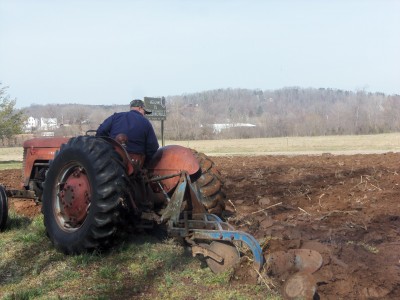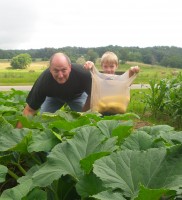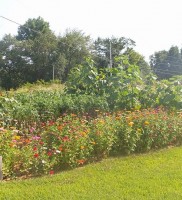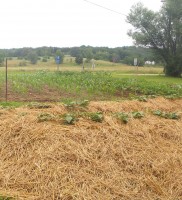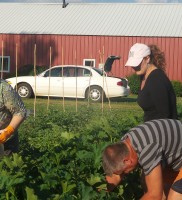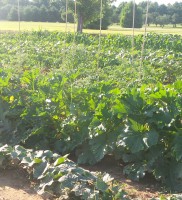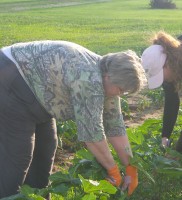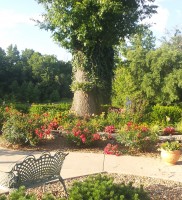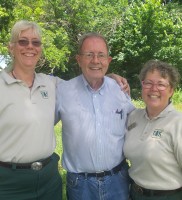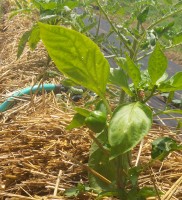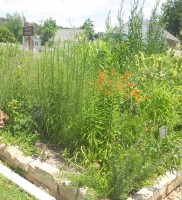Community Gardens Grow More Than Food and Flowers
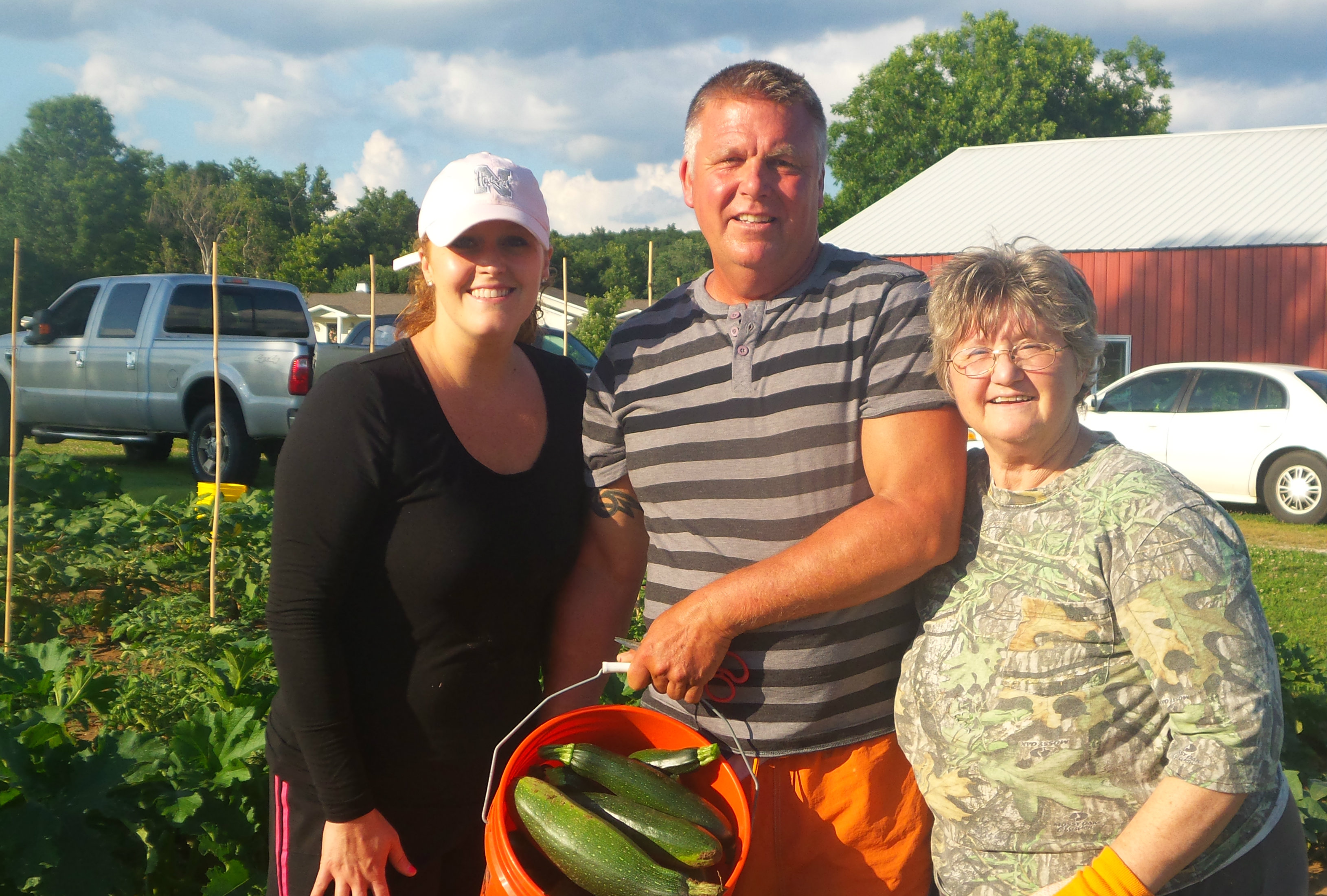
Above photo: Danielle Berry, Murray Hammond and Sarah Chaffin
When my family moved back to my husband, Brian’s, hometown of Williamsville four years ago, my wise farmer father-in-law, Jim Becker, encouraged me to get involved in the community garden located right next door to the house. The soil was so rich he grew sweet potatoes the size of an infant! As that first Williamsville winter slowly faded into spring, I thought I’d give it a shot.
With memories of beautiful gardens I witnessed growing up in Wisconsin, I chose a plot, designed my garden with the help of GrowVeg.com and started some plants from seed.
That first year was an eye-opening foray into the very difficult, albeit rewarding, world of a gardener. My biggest reward by far was making a new friend and fellow Wisconsinite, Don Schroeder. We shared a familiar heritage as well as the same ideas for what makes a successful and beautiful community garden. His sage gardening advice continues to be invaluable to me, not to mention his helping hand on a few scorching summer days. His stories make for time-suspending moments between chores in the summer heat. Our garden motto actually originated from a tale he tells of a motorcycle trip he once took through the scenic river routes near Lolo, Idaho. Carved into the log wall of a dilapidated old trapper shack he spent the night in was this sweet phrase that he ponders to this day:
Whoever plants a seed beneath the sod and believes, believes in God.
We have fun in our garden and thanks to Don, I can now stomach smooshing those gross potato beetles between my gloved fingers like it’s nothing to regain the upper hand over pests. There are several other garden members I’ve enjoyed gardening with who share the same love and vision for the community plot that greets passersby as they enter the city from the east.
As for some of the other realities of being a part of a community garden, I reflect upon the realization that the word “community” holds a variety of meanings to different people. One day I saw an unknown family frolicking through the garden, the kids filling sacks with okra, peppers and tomatoes with glee. I greeted them warmly and listened curiously as they proceeded to express their delight at having a community garden where they could just pick whatever they wished at any time. Inigo Montoya came to mind with that famous line, “You keep using that word (community). I don’t think it means what you think it means.” But I didn’t say it. I invited them to come back next week and work with me in the garden and I never saw them again. Much of the produce not canned and stored by the members is freely given away anyway. We grow A LOT of veggies!
To be honest, I must say that the term “community” begs definition at the onset to help members gain a clear idea of what they’re in for. I, for instance, hate weeds as much as I love the beauty and health of everything I grow, and the work it takes to achieve that aim is no small chunk of my week. Other gardeners arrive when the smell of freshly plowed dirt hangs thick in the April air with seedlings and spade in hand and return again in steamy late July to find (shock!) a field of wild, and very hardy grass suffocating the very life out of any other rooted living thing around it. I’d be lying if I said this didn’t challenge the whole “community” concept….
For neighbors, Danielle Berry, Murray Hammond and Sarah Chaffin, of Keener Springs area, the concept of a community garden is an opportunity to share a gorgeous plot on Murray’s property. Perfectly positioned for sun and a bit of shade, their large vegetable garden also includes a berry patch and room for fruit trees down the road. I visited with the three neighbors about a month ago as Sarah, a life-long gardener, tackled the weeds while Danielle and Murray picked okra and zucchini. Murray, known for his Midas design touch, shared his technique for harvesting produce to maximize freshness as Danielle and I listened. Danielle, a busy working mom of two young children, had tried her hand at gardening on her own but soon learned the value of combining her efforts with these great neighbors of hers.
Their vision for the garden is a cooperative model where everything is shared from the hard work to the fruits of their labor and their camaraderie gave me the hint that their sweet garden will be a great success for years to come.
I also had the pleasure of visiting another developing community garden effort currently underway in Poplar Bluff. After a needlessly complicated bureaucratic process of trying to acquire permits to utilize otherwise wasted flood plain property the city had bought from homeowners, a few dedicated citizens finally persevered with the newly-seated city council. I met with Jim Chrisman, Marge VanPraag and Sueanne Cmehil-Warn at the garden located at the corner of Ida and Spring Streets. They enthusiastically introduced me to their innovative method of gardening which utilizes straw bales as raised beds. Marge explained that the soil was nearly impossible to plow due to the house foundation still beneath the surface so she prepped the bales with a fish emulsion and planted tomatoes and peppers right in the straw.
All the little plants were coming along nicely! Sueanne pointed out a small plot of soil where they are employing the Three Sisters Method of companion planting of corn, beans and squash which utilizes the balanced diet each of the “sisters” contributes nutritionally to the others. Jim told me that the garden was inspired by a request for organic produce by Poplar Bluff’s very successful Iron Mountain Market held every Friday from 2-6pm and Saturday, 9am – 2pm, down at the beautiful, historic train depot. He beamed with pride that the city now offers these cutting edge opportunities for its citizens and the surrounding region.
Community gardens are popping up everywhere and rightfully so. In a crazy world we see constantly splashed across our TV and computer screens inside our houses, the gardens bring neighbors together and provide a serene setting in which to gather out in the open air. There, surrounded by the songs of birds and the flutter of butterflies, conversations bloom along with the flower buds and friendly connections are formed. There we work together to solve problems plaguing our rows of corn and pepper plants and we tackle current events with equal passion and resolve. There we provide food for our families and our community with our own hands and there’s great satisfaction in that. Perhaps we are drawn to our gardens to create beauty, work, laugh, dream and discover what Dorothy Frances Gurney speaks of in her verse:
The kiss of the sun for pardon
The song of the birds for mirth
One is nearer to God in a garden
Than anywhere else on earth

